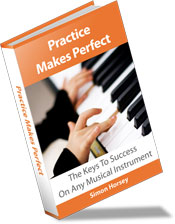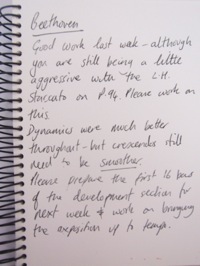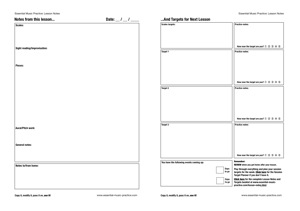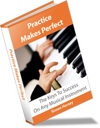Creative solutions
to all of your practice problems
In this issue...
1)Subscribers book discount - My new ebook Practice Makes Perfect is now available with a $5 discount for Perfect Practice subscribers...
2)Inspiring TED talk by Benjamin Zander - A lesson for us all, both in presentation and teaching about music! 3)Please prepare the following for next week...Do student and teacher always have the same perceptions of lesson notes? 4)Practice tip of the month - Finding the dream piece - Top practice tips from successful people inside and outside the music industry. Find out how to apply the strategies that took these people to the top of their field.
5)Software tip - There is a huge amount of music software available but none of it is really dedicated to practice. Read this section for advice on how to use different programs to improve your practice effectiveness. This month: Band In A Box!
News
1) Practice Makes Perfect eBook now available!
 My new ebook Practice Makes Perfect is now available - with a discount to all Perfect Practice readers! My new ebook Practice Makes Perfect is now available - with a discount to all Perfect Practice readers!
Practice Makes Perfect is the book that teaches you how to practice more efficiently and effectively. Applying the easy to use techniques in this book will revolutionize your practice enabling you (and your students) to make more progress in less time, whatever instrument you play.
Do you find you can play pieces at home but when you arrive at your lesson the pieces are never as good?
The solution to your problem is on page 23!
Do you find you make mistakes during exams and concerts and never play as well as you know you can?
The solution to your problem is on page 105!
Do you find you hit speed walls when playing faster pieces? This could be to do with the way you use a metronome.
Read page 66 for advice on how to avoid the speed wall.
Do you find yourself wishing you could make faster progress on your instrument?
If you answered yes to any of these questions you need the information in this book to help you: - Learn pieces faster
- Learn and memorize scales more easily
- Improve your sight-reading
- Improve your improvisation
- Work effectively towards exams and competitions
- Make the most of your lesson time
- Form your musical goals and work towards achieving them
Practice Makes Perfect really does contain the keys to success on any instrument. It is divided into four clear sections, each one packed with advice and tips on how to get the most from your practice time. We are all busy and I'm sure you only have limited time for practice. Practice Makes Perfect helps you make the most of that time, fine tuning your practice technique to be efficient and effective.
This is not a typical text heavy ebook. It is a colourful, easy to read book with illustrations, case studies, quotes and call-outs to break up the text and add interesting, inspirational information. Each aspect of practice is dealt with over one or two pages in simple, easy to follow language to help you apply the techniques to your playing quickly and easily.
Section 1 describes basic practice techniques, gives guidance on how to use the book and has an easy to use assessment tool to check your current practice habits.
Section 2 contains vital information on the relationship between how your brain works and how to practice music effectively using this information.
Section 3 contains the 12 keys to musical success.
Section 4 contains extra tips and advice on how to practice including using practice games, how to prepare for concerts, exams and competitions, using practice software and how to use a weekly focus to supercharge your progress.
Practice Makes Perfect retails at $14.95 and will be up on the Essential Music Practice website next week. However, I am offering subscribers to Perfect Practice a 33% discount for the next two weeks. When you click through to E-junkie to buy your copy just add the code ezinepromo in the discount box to receive your special pre-release discount. This means you pay only $9.95. I can only hold this open until 22nd May though...so get your copy today to make sure you don't miss out!
While Practice Makes Perfect is aimed primarily at people learning an instrument I am sure it will also become a very handy reference for teachers - not least because, as a PDF file, it is quickly and easily searchable! If you are an individual teacher, or a member of an institution and you are interested in licensing Practice Makes Perfect for your particular needs, please register your interest on the Essential Music Practice website
When you buy Practice Makes Perfect you will also have the option to download a Text Only Version (1.6MB). This will be available for $9.97 on the Essential-Music-Practice website next week as well... but you get it totally free with your purchase in case you want to print the book without pictures.
Just click on the 'add to cart' button below to be taken to the 100% secure E-junkie payment and download processor. The ebook is 8.5MB in size. For total financial peace of mind you can pay via PayPal or Google Checkout, and of course there is a 60 day, 100% money back guarantee with no questions asked if you feel your practice hasn't benefited from reading Practice Makes Perfect. You even get to keep the book!
Don't forget to add your discount code ezinepromo into the appropriate box to receive a 33% discount


2) Inspiring TED talk by Benjamin Zander
Those of you who are also subscribed to my RSS feed may have seen this already... if you haven't I'd highly recommend a visit to YouTube to see a video of his presentation.
Benjamin Zander is the conductor of the Boston Symphony Orchestra and teaches interpretation classes at the New England Conservatory as well as conducting their orchestra. I love his 'one buttock player' demonstration in the video. In terms of music practice I will be showing this to my students to remind them how practice needs to be musical and to listen to the way their sound. It's also a great advocate for videoing students to help them move away from the 'head bobbing on each beat' phase. There is something for us all to learn in this video - whether we are 'classical' musician or not! I think he may well have converted a few of the audience to classical music! Enjoy! I tend to show my students videos like this from YouTube as opposed to giving them the link. I find when I give the link they often return with four or five other links, instead of returning to tell me how they were inspired to start practising straight after seeing the video! I found this site where you can download YouTube videos which is very useful for not relying on the technical stuff working in lessons and presentations!
3)Please prepare the following for next week...
 I was teaching an IB Theory of Knowledge class on perception when it occurred to me that differences in perception could be responsible for some of the challenges I faced with my piano, clarinet and especially saxophone students. Was the student's perception of my requirements for next lesson the same as mine? I was teaching an IB Theory of Knowledge class on perception when it occurred to me that differences in perception could be responsible for some of the challenges I faced with my piano, clarinet and especially saxophone students. Was the student's perception of my requirements for next lesson the same as mine?
I decided to do an experiment and asked several of my students to keep a diary based on their practice and how it related to what I had asked them to do for next lesson. The students were also to record their playing when they felt they had achieved my requirements for the week.
thought I expected, but there was also considerable discrepancy between each student's assumptions of what was required. I realised this could only really be my fault and set about looking for a solution to this problem.
After reading countless articles and chapters of books I realised there was no 'ready made' solution suitable for my needs. I wanted a method of making notes for students that would - communicate my expectations precisely
- give students a way to plan their practice throughout the week
- give students a simple, quick self evaluation method to use and give me a simple way of giving my general evaluation as a comparison.
- Allow me to make a clear distinction between notes given on their playing during the lesson and targets to be achieved during the following week - so nothing could get 'lost in the mix'
- I also wanted to add a method of giving notice of upcoming performances/exams etc and a space for quick notes to parents - similar to our school homework diary.
Not too much to ask!
I set about designing and testing various forms until I found something both my students and I found useful. The basis of my lesson notes form is two areas. One for writing notes on the playing during the lesson. Technical observations, compliments on sections well played etc. and a separate section for writing weekly targets. I also began concentrating on making the way in which I wrote student's weekly targets much clearer. I begin defining exactly what my requirements were: hands separately or together for pianists, the metronome mark I required, the fact that all dynamics were to be included etc. The student have space to make any practice notes e.g. what metronome mark was achieved if the piece wasn't up to tempo, any difficulties encountered etc. Students also marked how near the set target they believed they were on a 1 - 5 scale. During lessons we discuss the self-evaluations, how near the target I believe the students are versus how near they believe they are, and over the course of a few weeks I found the students reaching and exceeding my expectations more and more.
I made sure my lesson notes form included sections for scale and pieces targets (I expect my students to alternate sight-reading and improvisation practice on a session by session basis) and also space within the lesson notes to comment on Aural training. The back of the single A4 sheet contained a space for further notes, a few lines of manuscript and a chart to help students plan their practice for the week.
My advice to all teachers and students after this experience is this: - Make sure you know the exact requirements. Students: ask questions of your teachers if you are not absolutely sure. Teachers: ask questions of your students to ensure they understand exactly what you require.
- Keep notes on previous work and targets for the coming week separate, but easily accessible. The student needs easy access to both, the teacher needs easy access to the targets during the following lesson.
- Have some kind of self-evaluation system for the student that is simple, easy and quick to use.
- Have a space where students can write brief practice notes and questions for next lesson.
- Have a space to 'count down' to important performances/exams (this only needs to be a box)

You can download a copy of my lesson notes form here and feel free to use it as is or alter it as you wish.
4)Practice tip of the month - Finding the dream piece
This month's tip is based on a quote from Martha Graham (1894-1991), an American dancer and choreographer. She said
"Practice means to perform, over and over again in the face of all obstacles, some act of vision, of faith, of desire.
Practice is a means of inviting the perfection desired."
The part that so often resonates with my students is "in the face of all obstacles" whereas I wish they would focus on "the perfection desired" or "some act of vision, of faith, of desire". For me, this is a question of repertoire. Do I just drive my students blindly through the 'standard' repertoire, encouraging them to finish book one, move on to book two, take Grade 4 and move on to Grade 5, or do I take the time to find out what the students really want to play? What pieces of music inspire them? How much time should I devote in their lesson to actually talk to the student about their dreams and aspirations in music, which pieces they dream of one day being able to play? I often feel that even the most demanding student could be a high flyer, if only I could find the right piece for him or her to play.
Of course, there needs to be a balance between dreams and current capabilities, but if there is a dream piece it is easier to map out a path to it with the student and discuss why each piece along the way is important. If he or she can see the progression to that one, amazing performance, if the vision is there, it is much easier to encourage the desire of perfection, and the "obstacles" become secondary, merely challenges to be overcome en route.
I had a student who learned Mozart's Variations on Twinkle, Twinkle Little Star because she heard it in a concert and really wanted to play it. Some of the variations were beyond her to start with, but she persevered and gave an excellent performance to the amazement of her peers and the joy of her parents. She found a dream piece and achieved something amazing.
I think it is important for teachers and students of music to find music that inspires us. So this month I challenge you to find a piece you really, really, REALLY want to play, find the music and start learning it... or at least plot a path through other pieces to practice the techniques needed to be able to learn one of your dream pieces.
Teachers: Challenge your students with this.
Students: Find a piece and take it to your teacher. Ask them to help you. Tell them how the piece inspires you. Ask them, and listen to their answers to help you plot a musical path to one of your dream pieces. You could be playing it faster than you think.
Find that piece that you will perform over and over again in the face of all obstacles and invite the perfection you demand of yourself...and enjoy the process into the bargain!
5)Software tip - Band in a box
As a jazz player I find Band In A Box invaluable when practising and other jazz musicians I have introduced to this software have quickly seen improvements in their playing as well.
Band In A Box basically provides a 'backing track' to enable you to play with a full band arrangement. You just mute the instrument you are playing, hit the button and play along!
- Select the appropriate style for your practice
There are hundreds of different styles in Band in a box and if the style you need isn't there you can also find many styles to download on the web with a simple google search - or it is quite easy to make your own!- Type in the chord sequence you are practising
This is about as easy as it can be! Literally type the chords into the empty bars! Again, there are many songs already shared by others on the internet.- Select instruments to mute
Pick the instrument you are practising and mute it in the arrangement- Hit play and away you go!
Optionally record your performance for review and evaluation later!
Quick, simple and perfect for practice Band in a Box is available both as and a windows version. Both of these versions are also available in my Amazon UK store and my Amazon US store where you will also find a new piece of software called Real Band Pro. Once I have found out a little more about this software I will feature it if I think it could be useful for practice. It would have to be very good to replace Band In A Box in my practice arsenal though!
Next month's featured software: Sequencers: How they can be used to support and inform your practice.
If you have something to say about practice in general, a tip to help other readers, you want to share a practice related story or you would like to contribute an idea or article to the Perfect Practice newsletter please click here to contact me.
Thanks for reading!
Simon
P.S. The promised update on my experience with the Peterson BB1 vibrating metronome..... I LOVE IT!
P.P.S. Don't forget you have a $5 discount on Practice Makes Perfect including a FREE copy of the Text Only Version for the next two weeks.


Enter the discount code ezinepromo and start practising smarter today!
Copyright info
I'm not a big fan of the way copyright laws operate in the world today. I could spend a huge amount of my time surfing the internet looking for people who have copied or translated parts of the Essential Music Practice site or Perfect Practice newsletters...however, I think it would be far more valuable to spend my time researching practice further and getting the information out to other musicians. Therefore, you are free to copy, forward or reproduce the content in this e-zine in any form you wish. I would appreciate an attribution and/or a link back to the Essential Music Practice website - but if you don't I won't come chasing you. I am a great fan of Creative Commons, but this is not under a creative commons license. You are free to use the information in any way whether commercial or non-commercial...if you make a million you can buy me a drink sometime!
New! Comments Have your say about what you've just read! Leave me a comment in the box below.
|



